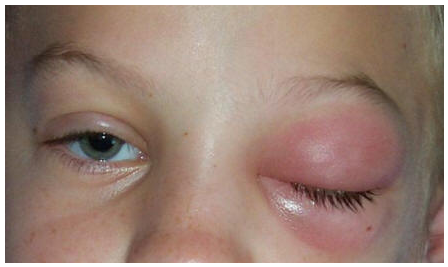

Orbital cellulitis is infection affecting the tissue within the orbit and around and behind the eye. Preseptal cellulitis is far more common than orbital cellulitis. However, orbital cellulitis is more dangerous.
CAUSE OF ORBITAL CELLULITIS:
It is caused by spread of an infection to the orbit from the sinuses around the nose (nasal sinuses) but can also be spread from infection of the teeth or bloodstream. An animal or insect bite or another wound to the eyelids can also spread infection and lead to orbital cellulitis.
CLINICAL FEATURE OF ORBITAL CELLULITIS: red and swollen eyelids, pain, and mild fever. Pain, A bulging eye (proptosis), Red eye, Reduced eye movement, Double vision, Pain with eye movement, Swollen eyelids.
Fever Orbital cellulitis presents with orbital signs, which are proptosis, eye movement restriction, decreased vision, restricted eye movements suggest orbital cellulitis.
PATHOGENESIS:
The fascia of the eyelids joins with the fibrous orbital septum to isolate the orbit from the lids. The orbital septum helps decrease the risk of an eyelid infection extending into the orbit. Infections arising anterior to the orbital septum are termed preseptal. Orbital cellulitis denotes infection posterior to the orbital septum and may cause serious complications, such as a cavernous sinus thrombosis, cerebral abscess, meningitis, septicemia. and optic neuropathy.
DIAGNOSIS:
COMPLICATIONS: permanent vision loss due to compressive optic neuropathy. Proptosis can cause corneal exposure, dryness, and scarring. Cavernous sinus thrombosis, intracranial extension, blindness, and death can result from severe orbital cellulitis.
HOMOEOPATHIC MANAGEMENT:
APIS MELLIFICA - relieves swollen eyelids with itching, relieved by cold compresses.
ARGENTUM NITRICUM- Swelling with yellowish or pus-like discharge, and redness and inflammation of the whites and inner corners of the eyes, suggest the use of this remedy, eyes may be tired and achy, worse from light and warmth, and better from cool water, cold compresses, and fresh air.
EUPHRASIA OFFICINALIS- relieves eye irritation with irritating tears and clear, non-irritant nasal discharge.
SULPHUR- Eyes are very red and irritated, with burning, smarting, sticking pains and a nagging itch. The whites of the eyes look red and bloodshot, and the tears feel hot. Symptoms are worse from heat, and light will hurt the eyes. The eyelids may look contracted, especially in the morning.
HEPAR SULPHURIS CALCAREUM - Eyes feel sore or bruised, with inflammation and burning pain, or a feeling as if the eyes are being pulled back into the head, this remedy may be indicated. Yellow discharge can stick the eyelids shut, especially in the morning. Warm compresses, and warmth in general, often ease discomfort. Extreme sensitivity to cold, as well as to light and noise, is often seen.
MERCURIUS SOLUBILIS- People needing this remedy often feel ill and tired, with erratic body temperature and sensitivity both to heat and cold. Discharge is greenish-yellow and can irritate the lids and margins of the eyes. A person who needs this remedy often has swollen glands, offensive breath, and excessive salivation.
NATRUM MURIATICUM- Swollen lids with burning tears and a feeling that the eyes are bruised suggest a need for this remedy. Mucus or pus forms and can make the eyelids stick together. People who need this remedy often feel sad and tired, acting irritable if someone shows them sympathy.
PULSATILLA- Conjunctivitis with thick, yellow, itchy discharge (often accompanying a cold or the measles) suggests a need for this remedy. The person is emotional and sensitive, feeling worse from warmth and in stuffy rooms, and relieved by cool fresh air.